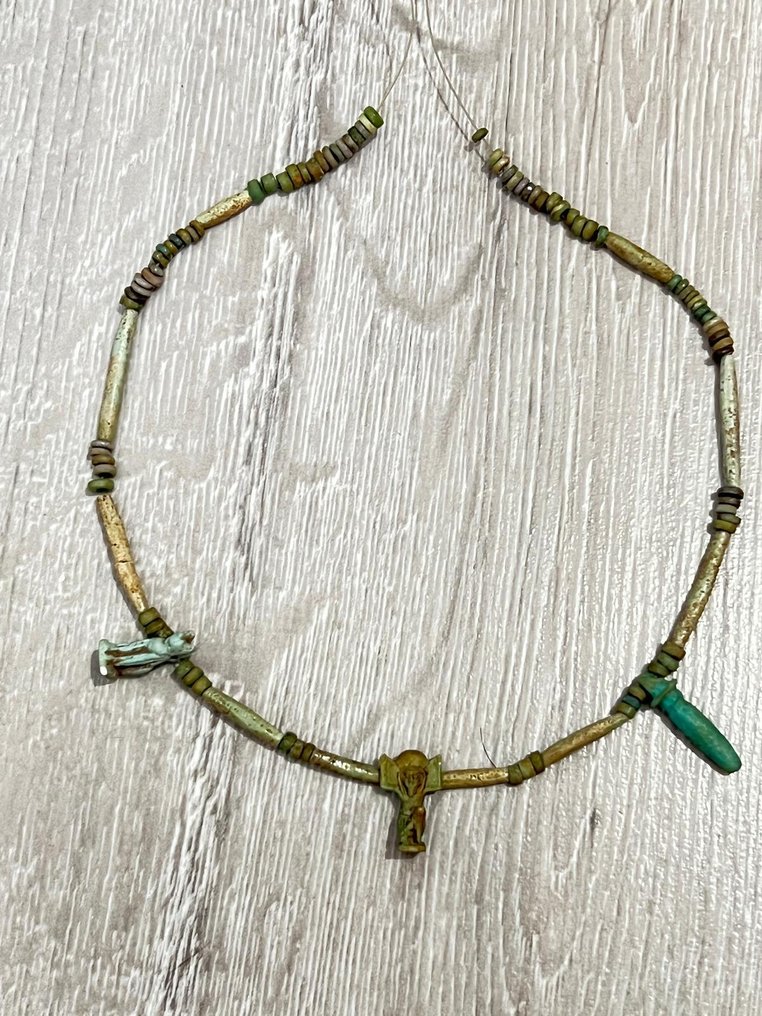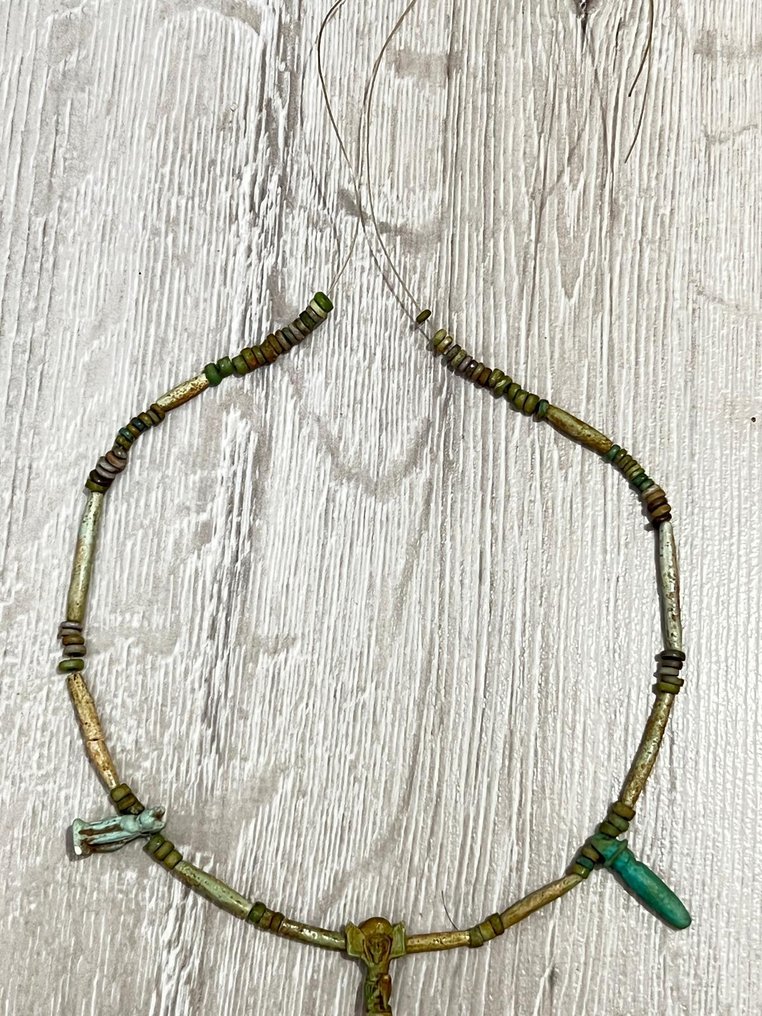conforme à la description avec plus de 50€ de taxes douanieres et retard pour verification tout est ok
Übersetzung ansehenAltes Ägypten, Neues Reich Fayence Halskette mit Götteramuletten - 20 cm
Nr. 92632747



Ancient Egypt, Amarna Period Necklace. ca 1353-1336 BC
The Amarna Period, a revolutionary epoch in ancient Egyptian history, occurred during the reign of Pharaoh Akhenaten (1353-1336 BCE). Known for its dramatic religious and artistic transformations, this era marked a significant departure from traditional Egyptian norms. Akhenaten established a monotheistic worship of Aten, the sun disk, and moved the capital to the new city of Akhetaten (modern-day Amarna). This period saw a flourishing of unique artistic styles, characterized by realistic and expressive depictions, a stark contrast to the idealized forms of earlier periods.
One of the most remarkable aspects of Amarna art is the use of faience in jewelry. Egyptian faience, a non-clay ceramic material, was highly prized for its lustrous glaze and vivid colors, predominantly blue and green, symbolizing life, fertility, and rebirth. The Amarna artisans mastered the technique of creating faience, which involved a complex process of molding, glazing, and firing silica-based materials.
Faience jewelry from the Amarna Period includes a wide array of items such as beads, amulets, rings, and pendants. These pieces were often adorned with intricate designs and motifs, including depictions of the Aten, floral patterns, and geometric shapes. The vibrant colors and glossy finish of faience made it a popular substitute for more expensive gemstones like turquoise and lapis lazuli, thus making ornamental jewelry accessible to a broader segment of society.
The use of faience extended beyond mere decoration; it held significant symbolic and religious meanings. Amulets and pendants made from faience were believed to possess protective and magical properties, warding off evil and ensuring the wearer's health and prosperity. The prominence of faience in Amarna jewelry reflects the era's artistic innovation and the socio-religious shifts that defined Akhenaten's reign.
In addition to personal adornment, faience objects were used in religious ceremonies and as grave goods, ensuring the deceased's safe passage to the afterlife. The production of faience required skilled craftsmanship, and the artisans of Amarna achieved a high level of proficiency, producing works that remain admired for their beauty and technical sophistication.
The Amarna Period stands out as a time of cultural renaissance, and the exquisite faience jewelry produced during this time exemplifies the artistic and symbolic advancements of Akhenaten's reign. The enduring legacy of these artifacts offers valuable insights into the innovative spirit and religious fervor that characterized this remarkable chapter in ancient Egyptian history.
Ancient Egypt, Amarna Period Necklace. ca 1353-1336 BC
The Amarna Period, a revolutionary epoch in ancient Egyptian history, occurred during the reign of Pharaoh Akhenaten (1353-1336 BCE). Known for its dramatic religious and artistic transformations, this era marked a significant departure from traditional Egyptian norms. Akhenaten established a monotheistic worship of Aten, the sun disk, and moved the capital to the new city of Akhetaten (modern-day Amarna). This period saw a flourishing of unique artistic styles, characterized by realistic and expressive depictions, a stark contrast to the idealized forms of earlier periods.
One of the most remarkable aspects of Amarna art is the use of faience in jewelry. Egyptian faience, a non-clay ceramic material, was highly prized for its lustrous glaze and vivid colors, predominantly blue and green, symbolizing life, fertility, and rebirth. The Amarna artisans mastered the technique of creating faience, which involved a complex process of molding, glazing, and firing silica-based materials.
Faience jewelry from the Amarna Period includes a wide array of items such as beads, amulets, rings, and pendants. These pieces were often adorned with intricate designs and motifs, including depictions of the Aten, floral patterns, and geometric shapes. The vibrant colors and glossy finish of faience made it a popular substitute for more expensive gemstones like turquoise and lapis lazuli, thus making ornamental jewelry accessible to a broader segment of society.
The use of faience extended beyond mere decoration; it held significant symbolic and religious meanings. Amulets and pendants made from faience were believed to possess protective and magical properties, warding off evil and ensuring the wearer's health and prosperity. The prominence of faience in Amarna jewelry reflects the era's artistic innovation and the socio-religious shifts that defined Akhenaten's reign.
In addition to personal adornment, faience objects were used in religious ceremonies and as grave goods, ensuring the deceased's safe passage to the afterlife. The production of faience required skilled craftsmanship, and the artisans of Amarna achieved a high level of proficiency, producing works that remain admired for their beauty and technical sophistication.
The Amarna Period stands out as a time of cultural renaissance, and the exquisite faience jewelry produced during this time exemplifies the artistic and symbolic advancements of Akhenaten's reign. The enduring legacy of these artifacts offers valuable insights into the innovative spirit and religious fervor that characterized this remarkable chapter in ancient Egyptian history.
- 5
- 0
- 0
conforme description merci ++
Übersetzung ansehenApres nombreux echanges enfin bien reçu le complément dece lot malgré taxe douanière en + par contre toujours rien des deux autres lots achetés peu après ils étaient encore en douane au 17 octobre
Übersetzung ansehenconforme rapide merci +++
Übersetzung ansehenconforme rapide merci +++
Übersetzung ansehen- 5
- 0
- 0
conforme à la description avec plus de 50€ de taxes douanieres et retard pour verification tout est ok
Übersetzung ansehenDisclaimer
Der Verkäufer garantiert und kann belegen, dass das Objekt legal erworben wurde. Der Verkäufer wurde von Catawiki darüber informiert, dass er die Unterlagen, die gemäß den Gesetzen und Vorschriften seines Landes erforderlich sind, zur Verfügung stellen muss. Der Verkäufer garantiert, dass er berechtigt ist, das Objekt zu verkaufen/auszuführen. Der Verkäufer wird dem Käufer alle Informationen, die zur Provenienz des Objekts vorliegen, zur Verfügung stellen. Der Verkäufer versichert, dass alle erforderlichen Genehmigungen eingeholt wurden/werden. Der Verkäufer wird den Käufer unverzüglich über etwaige Verzögerungen bei der Einholung dieser Genehmigungen informieren.
Der Verkäufer garantiert und kann belegen, dass das Objekt legal erworben wurde. Der Verkäufer wurde von Catawiki darüber informiert, dass er die Unterlagen, die gemäß den Gesetzen und Vorschriften seines Landes erforderlich sind, zur Verfügung stellen muss. Der Verkäufer garantiert, dass er berechtigt ist, das Objekt zu verkaufen/auszuführen. Der Verkäufer wird dem Käufer alle Informationen, die zur Provenienz des Objekts vorliegen, zur Verfügung stellen. Der Verkäufer versichert, dass alle erforderlichen Genehmigungen eingeholt wurden/werden. Der Verkäufer wird den Käufer unverzüglich über etwaige Verzögerungen bei der Einholung dieser Genehmigungen informieren.